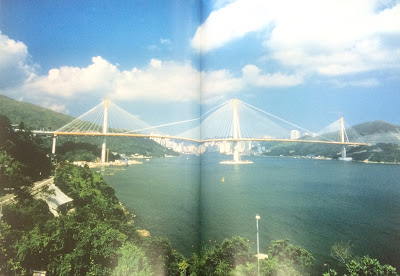In the morning of day two we were given some time to research bridges and different types of spanning and stilted structures that would aid our bridge building activity in the afternoon. It was also recommended that we go outside Ravensbourne and draw on the surrounding structures and sculptures for inspiration.
I particularly liked the spiralled structure of the Kilesberg Tower in Stuttgart and how the webbed affect on the outside not only acts as a safety precaution but also gives the structure an interesting aesthetic.

As part of my research, I found this picture of the Ice-Skating Tent at the Olympic Park in Munich (1983).
Immediately I thought this structure looked very much like the O2 centre next to Ravensbourne as it too is a tent-like structure and has a walkway over it which looks like the metal supporting structure on this building.
The sheltered walkway leading up to the O2 and Ravensbourne could also be classed as a "spanning structure" and seemed to mirror the O2's spiked pillar aesthetic.
Another structure I liked was the Footbridge over Gahlensche Strasse in Bochum as this also seemed to echo the same type of designs seen in the pictures above. I particularly found it interesting how the walkway was supported by wires coming down from the main spiked pillars as they almost looked like two sails on a ship.
I particularly liked the spiralled structure of the Kilesberg Tower in Stuttgart and how the webbed affect on the outside not only acts as a safety precaution but also gives the structure an interesting aesthetic.
Bellow are some more images of creative bridges.
Bellow are some pictures of other structures which caught my attention around Ravensbourne.

For the bridge building we were split into groups of 7 or 8 and combined ideas from the research we did earlier to make our structure. We were only allowed to use Cardboard, rubber bands, bamboo sticks and tape, and what made it even harder was that the structure could only touch the floor in two spots and it had to be tall enough so that a boat (a folded up table) could pass underneath it.
When my group started building we didn't have a fixed plan but developed the final idea as we were building. I think that we worked well as a team as each of us were doing something to help with the progression of the build. I felt that we automatically split off into two groups, with one half making the foundations for the bridge (the structures that would support it) and the other half making the road and other features above that would help the bridge to be stable and not collapse.
Our final design consisted of two foundation structures built out of bamboo sticks taped together in a pyramid-like way, an idea that was again based on the principle that triangles are the strongest structures. In addition the road was made by many pieces of cardboard taped together. The best part of the bridge however was the elastic band feature which helped to keep the road strong enough to support the car through tension. This same design feature can also be seen in a couple of the pictures I picked whilst researching and I really liked the outcome of this as I thought it also added decoration to the bridge.
Each of the group's bridges were put to the ultimate test at the end of the day when a remote controlled car had to be able to drive across them in both directions. Overall I found this activity really enjoyable as it was interesting to find different ways to hold up the structure and it was exciting to see which bridges worked.













No comments:
Post a Comment